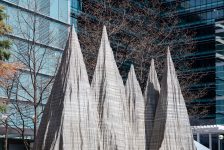Mountains have been a focus of Kapoor’s work for much of the 1980’s and 90’s, often relying on colour and size to accentuate symbolism of the theme. In his work, Mountain, Kapoor plays on the Canadian symbol that is the Rockies. Created with aluminium plate cut via water-jet, the plates are stacked to create this colossal and imperfect construction appearing to have been formed in the natural geological erosion. In the enclosed space that represents the courtyard, surrounded by fir trees, and confronted to the urban architecture of the various adjacent buildings, Mountain creates a natural space to take a breath and experience a moment while being surrounded by the buzzing pulse of the city. Mountain possesses an imposing air of grandeur, an awe-inspiring evocation of seismic forces and tectonic movement.
Kapoor has an ongoing fascination with negative space: “That’s what I’m interested in: the void, the moment when it isn’t a hole, it is a space full of what isn’t there.” The sublime and the infinite are paradoxically present in this nothingness.
Kapoor redefined contemporary sculpture in the 1980s through innovative approaches to scale, colour, volume and materiality, and by delving into the illusory. Perhaps most famous for public sculptures that are both adventures in form and feats of engineering, Kapoor’s works invite viewers to interrogate their relation to inhabited space. Whether through a seemingly infinite black hole or an impossible reflection, Kapoor confronts our expectation of optical perception, forcing a re-examination of one’s phenomenological experience.
One of the defining languages of Kapoor’s oeuvre is indisputably his manipulation of space, and the mirrored surface as a material in this endeavour can be seen internationally through his major public commissions. These highly reflective works combine an artistic subtlety with a powerful monumentality, contrasting the stillness of a flawlessly polished surface with an ever-oscillating echo of its environment. Each transcends the boundaries of their volume, capturing a metaphorical infinity across an indescribable surface.


